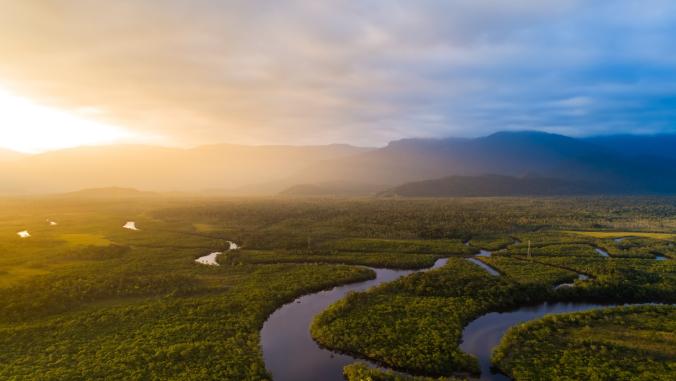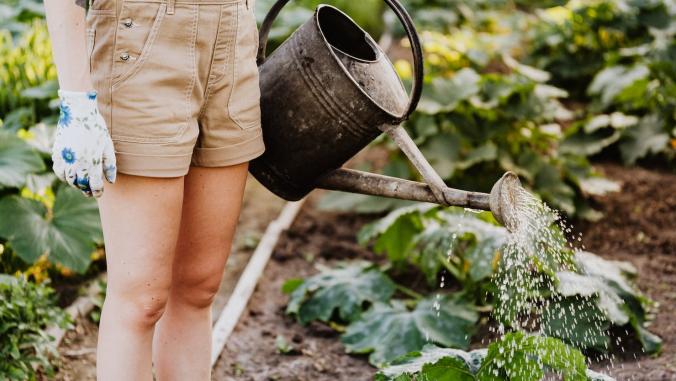I’ve lived in California for over four years and, as an avid explorer, have driven past my fair share of farmland during that time. During the dry season — which means most of the year — almond, avocado and citrus orchards break up the brown and dry landscape with their lush and neatly lined trees. I’ve always been curious to see one of these big orchards from the inside and finally got a chance to venture in.
A few weeks ago, I joined a demonstration of regenerative agriculture practices for almonds hosted by KIND — the New York-based food company best known for its granola bars. Before the tour to an orchard outside of Fresno in central California, the KIND team urged everyone to hop on a group bus rather than drive to the orchard themselves because it was supposedly hard to find. How difficult can it be — I thought — given that nowadays you can find everything when equipped with a smartphone and the correct coordinates? But I’m glad I followed their advice.
While the orchards already look fairly large from the freeway, that impression doesn’t even hint at their actual scale. Once our bus turned off the highway and into the orchard, we didn’t roll up the driveway of an idyllic family farm surrounded by trees. Instead, we drove down a paved road, then a dirt road and finally a dirt path. For 15 minutes, we kept going deeper and deeper into the almond maze until we finally arrived at demonstration site.
Almonds’ complicated truth
Why all this effort to look at some trees? Well, almonds have been juggling a somewhat controversial existence for the past years. They’re one of the more nutritious and climate-friendly foods and have experienced exploding demand with the rising popularity of almond milk, yogurt and other dairy alternative products. About 80 percent of the world’s almonds grow in California. According to my calculations, almond orchards have increased by 78 percent from 2010 to 2022, reaching a size that could cover Manhattan 96 times.
This has led to a closer examination of farming practices and a debate over related local impacts. Almonds are a thirsty crop, but California is a dry region. Thus the expansion of almonds and other orchards has put further pressure on water allocation in the state. Almond farming is also exceptionally demanding and harsh for wild and commercial bees. During pollination in late February, about 90 percent of U.S. commercial honey bees operate in California’s almond orchards. They expose each other and wild bees to diseases, compete over forage and get subjected to pesticides. Finally, production impacts the health and well-being of neighboring communities — almond harvests produce dust storms and plumes of smoke arise when farmers burn old trees in the fields at the end of their 25-year lifespan.
It’s like a Fitbit for your tree, so you can understand its heartbeat in real-time and measure whether it’s thirsty.
Some companies with significant almond footprints have noted these concerns and responded with initiatives to mitigate them. For example, health food companies Simple Mills, Daily Harvest and Cappello’s collaboratively launched the Almond Project last year. It tests cover crops, animal integration, compost and input reduction to improve soil health and climate resilience on 160 acres of almond crops over five years.
Scaling regenerative practices
Now, KIND is enrolling 500 acres of orchards into its own pilot program, which it will implement with its supplier Olam Food Ingredients (OFI), one of the three largest almond producers in the world. The harvest from these areas will make up 10 percent of KIND’s almond supply chain. The company is experimenting with four main approaches to improve sustainability over the coming three years:
1. Sub-surface irrigation to increase water efficiency
Almond growers have already come a long way when it comes to irrigation. According to Zac Ellis, senior director of agronomy at OFI, they made a massive leap over the past 20 years by moving from monthly flooding of the entire orchard to adopting drip irrigation as the new industry standard. Even so, water use remains of concern. The next step would be to use a sub-surface irrigation system that dispenses water directly to the tree’s roots rather than applying it on top of the soil to reduce evaporation.
To see whether this provides the trees with enough water, OFI is combining it with a dendrometer in the KIND pilot. "It’s like a Fitbit for your tree, so you can understand its heartbeat in real-time and measure whether it’s thirsty," Ellis said. Installing the underground system is costly, so one of the pilot’s aims is to understand if the water savings and potentially bigger yields from adopting the new technology make up for the investment.

Zac Ellis, Senior Director of Agronomy at OFI, and Caitlin Birkholz, Regenerative Agriculture Pillar Lead at KIND, explaining biochar and composting practices. Image by Theresa Lieb/GreenBiz.
2. Cover crops for healthy soils and happy bees
The pilot uses a mix of five cover crops — clover, white mustard, triticale, sweet clovers and phacelia. They could increase biodiversity in the orchard, provide more pollinator habitat and offer various soil health improvements, such as nitrogen fixation, erosion prevention and weed suppression.
But the cover crops won’t be able to freely grow year-round. They must be mowed before the almond harvest season from August through October so the nuts can dry on the ground after being shaken off the trees. Testing for organic matter, soil carbon and bee health will evaluate whether the cover crops were effective and whether their benefits outweigh seed cost and maintenance needs.

This innovative off-ground harvester could protect surrounding communities from dust storms and reduce carbon emissions. Image by Theresa Lieb/GreenBiz
3. Off-ground harvest to reduce soil disturbance, dust and fuel use
Currently, the first step for harvesting almonds is using a machine that grabs the trunk of a tree and then shakes the almonds to the ground. Second, another machine sweeps the almonds into rows in between the trees so they can dry before being collected. The sweeping process disturbs the soil and creates dust clouds, a significant regional health concern.
KIND is helping OFI test a new off-ground harvesting machine. It shakes the trees, collects the almonds and then automatically places them into rows. This way, growers can get around the sweeping process and halve the number of heavy-duty fuel-consuming machines that operate during harvest time. But these new harvesters haven’t undergone much practical testing yet, Ellis told me. Because they cost around half a million dollars, growers are reluctant to invest. He hopes the experience collected in this pilot will increase their confidence.
4. Whole orchard recycling, plus biochar and compost
Finally, instead of burning almond trees at the end of their 25-year lifespan, the pilot will grind up the trees and reintegrate them into the soil. This step promises to avoid emissions and air pollution from the tree-burning fires that have been standard practice. It will also cycle nutrients back into the soil, hopefully decreasing the need for synthetic fertilizers.
KIND and OFI are also experimenting with a new process that breaks down almond shells into biochar. They plan to mix the biochar with compost and work both into the orchard, which could boost soil health and biodiversity, further reducing fertilizer and water use.
It’s inspiring to see how many tools almond growers could leverage to improve their social and environmental impact, and pilots such as this one are essential in ground-proofing these ideas. But when strolling through the orchard, I couldn’t shake off a rather anxious feeling. This monoculture farm is enormous and structural issues such as California’s water shortage challenge its continued existence — even when imagining what it might look like three years from now, with healthier soil, flourishing cover crops and more bees.
I asked Ellis if he could imagine moving to a more integrated system, mixing almonds, avocados, oranges and other trees, and perhaps integrating grazing livestock. Without having to think about it for a second, he shook his head, saying that it would be too hard to manage and wouldn’t make economic sense.
Then I asked the KIND team whether they were trying to redesign products with less problematic ingredients and leverage the power of their brand to shape consumer preferences. More shaking heads. Unless there are systemic changes, it seems that a less bad version of monocultural orchards might be the best California can hope for.
But on a planetary scale, this could be OK. Suppose the state’s high yields avoid the conversion of natural ecosystems elsewhere into less efficient almond orchards. In that case, we’d preserve an overall larger area of intact ecosystems — a global win with respective local tradeoffs.






